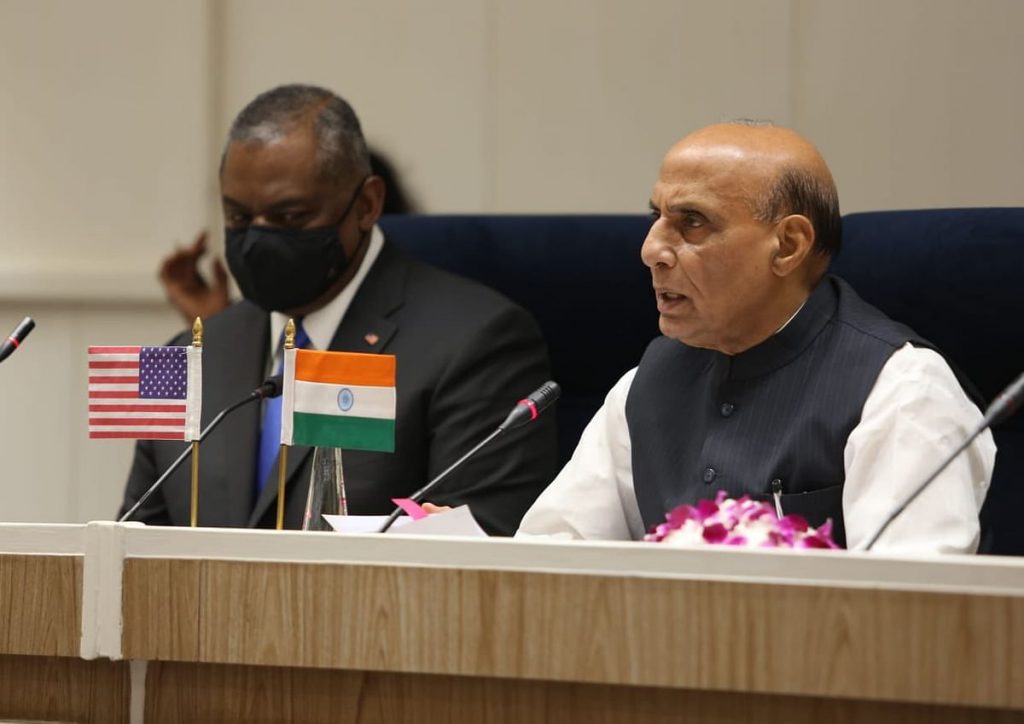India needs to tread cautiously while intensifying defence cooperation with the US Commands in the Indo-Pacific region and Africa ostensibly to checkmate China. Defence Minister Rajnath Singh sounded confident during a joint media address along with US Secretary of Defence General (Retd) Lloyd James Austin III on March 20 with whom he reviewed a wide range of bilateral and multilateral exercises and agreed to pursue enhanced cooperation with the US Indo-Pacific Command, Central Command and Africa Command.
Obviously, the US is trying to cash in on Sino-Indian tension over the border skirmishes in Ladakh and at the same time safeguard its own interests in the Indo-Pacific region for which Austin hinted at Beijing’s growing military activities in the South China Sea zone. He was quick to point out India-US defence partnership will grow in the coming years since it stands for freedom of navigation and overflight, unimpeded lawful commerce and adherence to international laws.
As is well known since long, ties with the US always come with strings attached. Over-dependence on the US enables it to dictate terms to its partner country. Last week, top Biden administration officials were in Tokyo and Seoul where they got red carpet welcome because the two Northeast Asian countries are Washington’s full-fledged treaty allies.
But, India is a different ball game for the US. True, India has closer cooperation with the US, allowing American warplanes to refuel at India’s islands or engaging with the Quad countries on coronavirus vaccines and drawing up common strategy to take on China in the Indo-Pacific region. The thorn in the flesh of Indo-US ties, however, is that India is still doing business with Washington’s adversaries, the latest being the inking of a $5.5 billion deal for the Russian S-400 air defence system. The future delivery of the weapon systems could expose New Delhi to the risk of American sanctions and put a brake on the Indo-US relationship.
Turkey’s purchase of the same Russian system has already strained its ties with the US which imposed sanctions against a Turkish institution that manages the defence industry. The real reason for the sanction is that the US and NATO-allied countries fear that Turkey’s deployment of the S-400 could neutralise the advanced F-35 fighter jet’s stealth capabilities by exposing it to the Russian system’s powerful radar. This prompted the US Defence Department to expel Ankara from the advanced fighter jet programme in July 2019. The Trump administration ultimately issued very limited sanctions on Turkey in December 2020 so that the country’s economy was not shattered creating further problems to NATO members.
Another reason for US’ opposition to India obtaining the Russian missile system is that Russian arms, that constitute a big chunk of India’s arsenal, have a lower price tag and fewer strings attached than US arms sales. Moreover, unlike the US, Russia doesn’t mix its arms deals with human rights rules and conditions. This outweighs the disadvantage of arms trade with Russia keeping India dependent on it for maintenance and spare parts.
On the other hand, the Russian S-400 system scores over the US Patriot missile system with its larger, longer-range Terminal High Altitude Area Defence capabilities.
This explains why the US has tried to use the continued instability on India’s border with China to nudge New Delhi away from its traditional nonaligned status and embrace it as its strategic partner. The government is also conveniently wilting under the pressure and slowly and carefully shedding New Delhi’s nonalignment strategy. India is learnt to have sent signals to the US about its concern over Beijing’s navy moving between Africa, the Persian Gulf, Bay of Bengal and the Strait of Malacca as well as Chinese buildups in Sri Lanka and at Pakistan’s Gwadar Port, as well as in Djibouti.
India should not lose sight of the fact that it needs the US to keep China at bay as much as the US needs India to protect its own interests in the South China Sea region. Hence, it would be wrong to overturn the country’s old time tested approach as is being done and continue to benefit from both the US and Russia.
